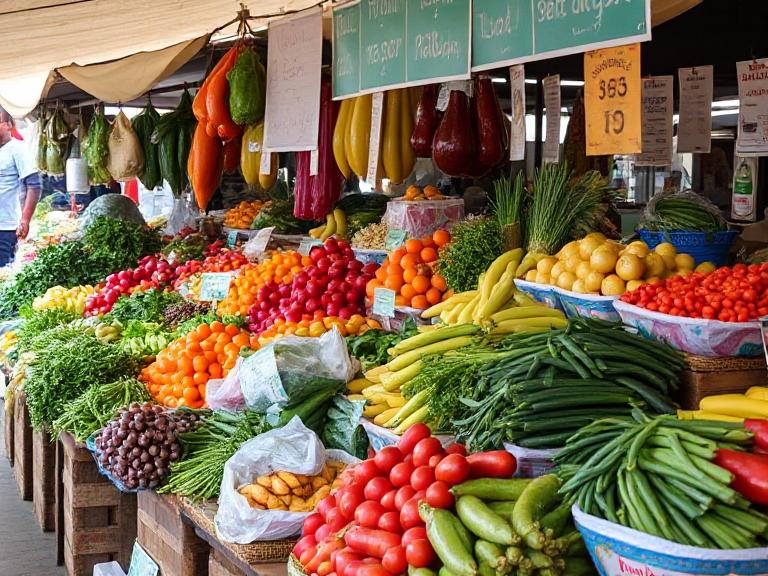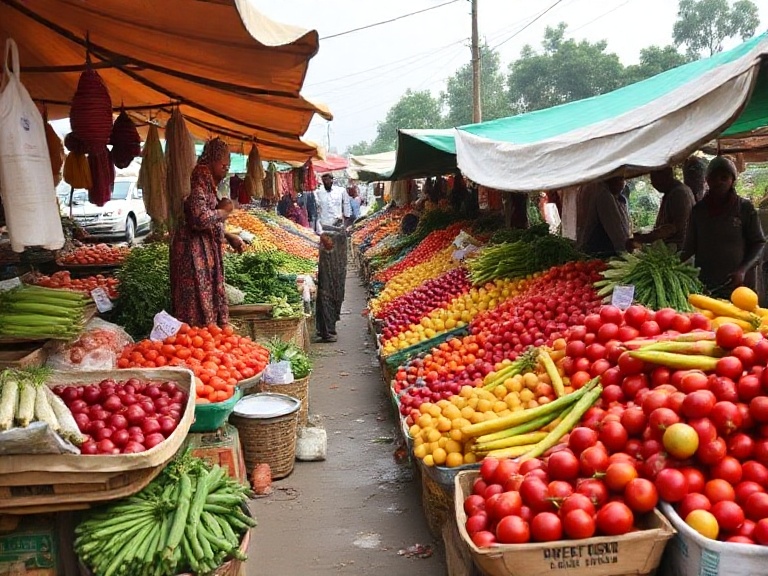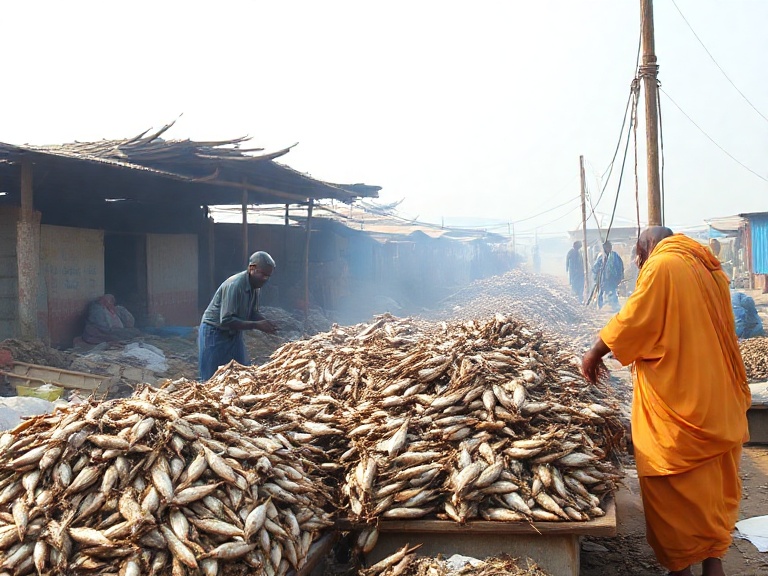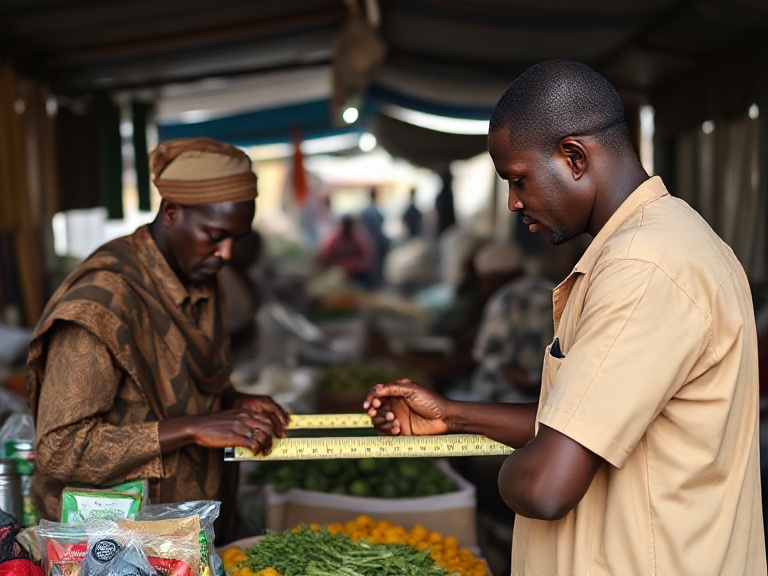The Ingredients That Define Abuja: Markets, Staples & Where They Come From
Hussein - AbujaEats
Food Writer & Critic

Understanding Abuja's food scene requires knowing where ingredients come from and how they reach your plate. The capital's markets serve as the vital link between Nigeria's agricultural regions and the city's restaurants and homes. This journey through Abuja's markets and ingredients reveals the foundation of the city's culinary culture.

Wuse Market: The Culinary Epicenter
Overview
Wuse Market stands as Abuja's largest and most diverse food market. This sprawling complex houses thousands of vendors selling everything from fresh produce to dried goods, spices to proteins. For chefs, home cooks, and food enthusiasts, Wuse Market represents the heart of Abuja's ingredient supply chain.
What You'll Find
Fresh Produce Section: Tomatoes, peppers, onions, leafy greens, and seasonal vegetables arrive daily from farms across Nigeria. The variety reflects Nigeria's agricultural diversity—from Northern yams to Southern vegetables.
Protein Markets: Separate sections for fresh fish, dried fish, beef, goat meat, chicken, and bush meat. The fish section particularly impresses with varieties from both ocean and freshwater sources.
Spice and Condiment Vendors: Locust beans, dried peppers, ground crayfish, palm oil, and countless other flavor essentials. These vendors often grind spices fresh to order.
Grain and Staples: Rice (local and imported), beans, garri, yam flour, and other carbohydrate staples that form Nigerian cuisine's foundation.
Best Times to Visit
Early Morning (6-9 AM): Freshest produce, best selection, cooler temperatures. Professional chefs shop during these hours.
Mid-Morning (9-11 AM): Still good selection, slightly less crowded than peak hours.
Avoid Midday: Heat, crowds, and picked-over selection make midday visits challenging.
Evening (4-6 PM): Some vendors offer discounts on produce they don't want to store overnight.
Navigation Tips
- Wear comfortable, closed-toe shoes
- Bring cash in small denominations
- Expect to bargain—initial prices are often negotiable
- Watch your belongings in crowded areas
- Ask vendors about seasonal availability
- Request recommendations for specific ingredients

Garki Market: The Modern Alternative
Character
Garki Market offers a more organized, modern market experience compared to Wuse's sprawling chaos. The ultra-modern market building provides cleaner, more structured shopping with better facilities.
Advantages
Organization: Clearly defined sections make navigation easier Cleanliness: Better maintained than traditional markets Facilities: Proper restrooms and parking Pricing: Generally slightly higher but more transparent Comfort: Air-conditioned sections in some areas
What Makes It Special
Garki Market attracts middle-class shoppers who value convenience and cleanliness alongside quality. Vendors here often cater to more discerning customers, affecting both quality and price points.
Best For
- First-time market visitors
- Those preferring organized shopping
- Families with children
- Shoppers prioritizing cleanliness
- People seeking specific imported items
Seasonal Ingredients and Availability
Rainy Season (May-September)
Abundant: Leafy vegetables, fresh corn, garden eggs, okra, fresh peppers Peak Quality: Most vegetables reach peak flavor during rainy season Challenges: Some items become muddy or damaged from rain Prices: Generally lower due to abundance
Market Strategy: Buy leafy greens and vegetables at peak freshness. Stock up on items for preservation.
Dry Season (November-March)
Abundant: Tomatoes, onions, root vegetables, dried goods Peak Quality: Tomatoes especially excellent during dry season Challenges: Some leafy greens become scarce or expensive Prices: Vary by item—some cheaper, others more expensive
Market Strategy: Focus on items at peak season. Buy dried goods for storage.
Harmattan (December-February)
Special Considerations: Dust affects fresh produce appearance but not always quality Abundant: Root vegetables, dried goods, preserved items Challenges: Dust requires extra washing Prices: Stable for most items
Market Strategy: Wash produce thoroughly. Focus on items less affected by dust.

Essential Nigerian Ingredients
The Holy Trinity: Tomatoes, Peppers, Onions
These three ingredients form the base of most Nigerian dishes. Understanding their varieties and uses is fundamental.
Tomatoes:
- Plum tomatoes (most common for cooking)
- Cherry tomatoes (eating fresh)
- Canned tomato paste (backup option) Seasonality: Best December-March Storage: Room temperature until ripe, then refrigerate Selection: Firm, unblemished, deep red color
Peppers:
- Scotch bonnet (hottest, most flavorful)
- Tatashe (sweet red pepper, mild)
- Shombo (long red pepper, medium heat)
- Green bell peppers (mild, for color) Seasonality: Year-round, best during rainy season Storage: Refrigerate in paper bag Selection: Firm, glossy skin, no soft spots
Onions:
- Red onions (most common in Nigerian cooking)
- White onions (milder, for specific dishes)
- Spring onions (garnish and flavor) Seasonality: Year-round Storage: Cool, dry place with air circulation Selection: Firm, dry outer skin, no sprouting
Leafy Greens
Ugu (Fluted Pumpkin Leaves):
- Most popular vegetable in Nigerian cuisine
- Mild flavor, nutritious
- Used in soups and stews Availability: Year-round, best during rainy season Selection: Bright green, no yellowing
Bitter Leaf:
- Distinctive bitter flavor
- Medicinal properties
- Requires washing to reduce bitterness Availability: Year-round Selection: Fresh, not wilted
Water Leaf:
- Tender, mild flavor
- Cooks down significantly
- Popular in soups Availability: Year-round, best when fresh Selection: Crisp, bright green
Scent Leaf (Nchanwu):
- Aromatic herb
- Used for flavoring
- Similar to basil in application Availability: Year-round Selection: Fragrant, bright green
Proteins and Dried Goods
Stockfish:
- Dried cod, essential in many soups
- Requires soaking before use
- Adds unique flavor and texture Selection: Firm, not too dry, no mold
Dried Fish:
- Various species, smoked and dried
- Intense flavor
- Long storage life Selection: Good aroma, no excessive salt
Crayfish:
- Ground dried shrimp
- Flavor enhancer
- Essential in most Nigerian soups Selection: Fresh aroma, fine grind, reddish color
Palm Oil:
- Red oil from palm fruit
- Essential for authentic Nigerian flavor
- Rich in vitamins Selection: Deep red color, liquid at room temperature

Specialty Markets and Vendors
Utako Market
Character: Smaller, neighborhood market Specialties: Fresh produce, daily essentials Best For: Quick shopping, local prices Timing: Morning hours for best selection
Kubwa Market
Character: Large traditional market Specialties: Bulk buying, wholesale prices Best For: Stocking up, budget shopping Timing: Early morning for wholesale deals
Dutse Alhaji Market
Character: Traditional market with authentic atmosphere Specialties: Northern Nigerian ingredients Best For: Specific regional items Timing: Morning to early afternoon
Specialty Ingredient Shops
Asian Stores: Chinese, Indian, and other Asian ingredients Locations: Scattered in Wuse 2, Garki Best For: International cooking needs
Organic Produce Vendors: Growing number of organic suppliers Locations: Farmers markets, specialty shops Best For: Chemical-free produce
Spice Specialists: Vendors focusing on quality spices Locations: Within major markets, standalone shops Best For: Serious cooking, bulk spice buying
Farm-to-Plate Journey
Agricultural Regions Supplying Abuja
Jos Plateau: Vegetables, Irish potatoes, carrots Middle Belt: Yams, cassava, rice Northern States: Onions, tomatoes, peppers (dry season) Southern States: Plantains, palm oil, seafood Local FCT Farms: Fresh vegetables, eggs, poultry
Supply Chain
Farmers: Grow and harvest produce Aggregators: Collect from multiple farms Transporters: Move goods to Abuja markets Wholesalers: Sell bulk to retailers Retailers: Market vendors selling to consumers Restaurants/Homes: Final destination
Challenges
Transportation: Road conditions affect delivery times and costs Storage: Limited cold chain infrastructure Seasonality: Some items unavailable off-season Pricing: Fluctuates based on supply and demand Quality Control: Variable standards
Shopping Like a Local
Bargaining Basics
Starting Point: Vendors often quote 20-30% above target price Counter Offer: Start at 60-70% of quoted price Negotiation: Meet somewhere in the middle Bulk Discounts: Buying multiple items or larger quantities Regular Customer: Building relationships leads to better prices
Quality Assessment
Produce:
- Firmness indicates freshness
- Color should be vibrant
- Smell should be fresh, not off
- No excessive bruising or damage
Proteins:
- Fresh smell (not fishy or sour)
- Firm texture
- Proper color for type
- No sliminess
Dried Goods:
- No moisture or mold
- Good aroma
- Proper packaging
- Check expiration dates
Quantity Guides
"Derica" Measurements: Tomato paste tins used as measuring units "Congo" or "Mudu": Traditional volume measurements "Bunch": Standard grouping for leafy vegetables "Heap": Pile of produce (size varies by vendor)

Preserving and Storing Ingredients
Traditional Methods
Sun Drying: Peppers, fish, vegetables Smoking: Fish, meat Fermentation: Locust beans, ogiri Oil Preservation: Storing in palm oil
Modern Storage
Refrigeration: Most fresh produce, proteins Freezing: Prepared ingredients, excess produce Vacuum Sealing: Extended storage Proper Containers: Airtight for dried goods
Shelf Life Guidelines
Fresh Vegetables: 3-7 days refrigerated Fresh Proteins: 1-2 days refrigerated, months frozen Dried Goods: Months to years in proper storage Spices: 6-12 months for optimal flavor Palm Oil: Months at room temperature
Supporting Local Agriculture
Benefits of Local Sourcing
Freshness: Shorter supply chain means fresher ingredients Economics: Money stays in local economy Sustainability: Reduced transportation impact Quality: Direct relationships with farmers Cultural Preservation: Maintains traditional farming
Finding Local Producers
Farmers Markets: Direct farm-to-consumer sales Farm Cooperatives: Group selling arrangements CSA Programs: Community supported agriculture Direct Farm Visits: Some farms welcome visitors Online Platforms: Growing digital marketplace
Market Safety and Etiquette
Safety Tips
Valuables: Keep phones and wallets secure Cash: Bring only what you need Awareness: Stay alert in crowded areas Timing: Avoid very early or late hours Company: Consider shopping with others
Market Etiquette
Respect: Treat vendors courteously Touching: Ask before handling produce Bargaining: Negotiate respectfully Purchases: Don't waste vendors' time if not buying Photography: Ask permission before taking photos
Your Market Journey
Abuja's markets offer more than just shopping—they provide insight into Nigerian food culture, agricultural traditions, and the journey ingredients take from farm to plate. Understanding these markets deepens appreciation for the meals they make possible.
Start with a guided market tour or visit with someone experienced. Learn to identify quality ingredients, understand seasonal availability, and build relationships with vendors. The knowledge gained transforms cooking and eating, connecting you more deeply to Abuja's culinary landscape.
The ingredients that define Abuja come from across Nigeria, converging in markets where tradition meets modernity, where farmers' labor becomes family meals and restaurant dishes. Your exploration of these markets is an exploration of Nigerian food culture itself.
Discover more about Abuja's food markets and ingredients. Follow AbujaEats for market guides, ingredient spotlights, and tips for shopping like a local in Nigeria's capital.
Never Miss a Food Review
Join our community of food lovers and get weekly restaurant recommendations, exclusive dining tips, and the latest food news in Abuja.
Own a Restaurant in Abuja?
Get featured on AbujaEats and reach food lovers across the city.
List Your Restaurant

